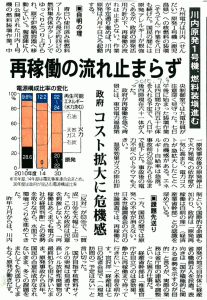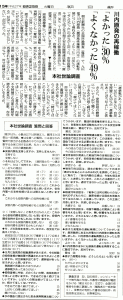Original Japanese written by staffer
The English below translated from the original Japanese by Heeday
The English translation edited by Rev. Dr. Henry French, ELCA
(Source: article of July 9th, 2015 edition of the Fukushima Minpo newspaper)

On August 11th, 2015, after almost two “nuke-free” years, a Japanese nuclear power plant was restarted, without the majority of the people consenting.
Prior to the restart of Unit 1, Sendai Nuclear Power Plant of Kyushu Electric Power, many citizens of Japan were worried about the nuclear plants’ safety. The Japan Association for Public Opinion Research conducted a public opinion poll in June 2015, which found that 63% of the respondents were opposed to the restart, a much larger number than the 31% who were in favor of it. Thus, the Japanese Government kept claiming that “the restart was a business decision of the power company,” while facilitating the restart below the surface.
Nippon Hoso Kyokai (NHK, Japan Broadcasting Corporation) conducted another public opinion poll. In response to the question “Are you in favor of the Sendai Nuclear Power Plant’s restart or opposed to it?” 32% were in favor of it, with 57% of the respondents opposed.
The survey asked another question: “In response to the Fukushima Daiichi disaster, Japan has set up a new nuclear plant safety standard. Do you think a plant satisfying this new standard can, some day, be hit by an accident that necessitates evacuation of the residents in its vicinity? Or do you think such an accident will not take place?” 81% of the respondents said “yes,” with only 10% saying “no.”
Yet another question went: “The relevant municipalities are making evacuation plans to follow in case of a nuclear power plant accident. The national government says, while it will provide assistance to such planning, it has no need to examine the plans. What is your opinion on this attitude of our national government?” To this, 8% replied “Just giving assistance is good enough,” while 82% said “Just providing assistance is not good enough. I believe the national government should examine evacuation plans prepared by municipalities.”
Thus, all in all, the majority of the people are opposed to the restart. Facing this opposition, the national government says the Cabinet is in no position to affect the final decision of whether or not to restart a particular nuclear power plant. The decision is left to the plant’s operators.
(Source: article of August 25th, 2015 edition of the Asahi Shimbun newspaper)

A nationwide phone survey by the Asahi Shimbun (a nationwide newspaper), conducted shortly after the Sendai Plant’s restart, found that 49% of the respondents said the restart was “no good,” outnumbering the 30% who said it was “good.” To the question what we should do with nuclear power, 16% responded “Eliminate it soon,” while 58% said we should “Eliminate it in the near future,” and only 22% responded “Retain it.”
Japan’s current Cabinet has refused to respond sincerely to the people’s opinions and approved the restart without sufficient consideration, consultations, etc. And now, many other power companies are trying to follow this example. When nuclear power plants are restarted against the will of the majority of the people, whom do they serve? I wish that everyone would learn about the agonies suffered by those affected by the Fukushima Daiichi tragedy. Then, I am convinced, no one would be pro-nuke.
